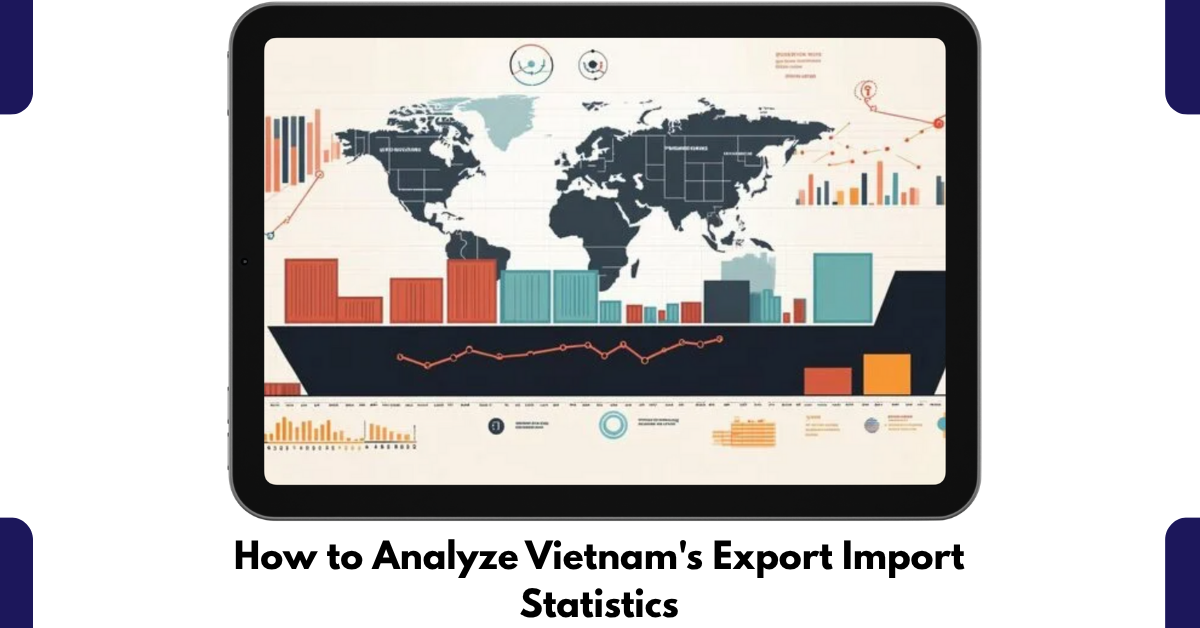Understanding Vietnam’s Global Trade Dynamics
In the fast-evolving context of international trade, Vietnam export import statistics 2025 have become a crucial benchmark for policymakers, investors, and trade analysts. Since the last decade, Vietnam has evolved from being a small manufacturing center to one of Asia’s most dynamic trading countries. Its economic path is a saga of industrial development, policy realignments, and integration with the world.
From textiles and electronics to farm products, Vietnam exports have penetrated markets on continents, as imports of machinery, raw materials, and advanced technology continue to power local industries. To properly interpret Vietnam export import statistics, one has to go beneath the surface of figures and penetrate to data trends, relationship of trade, and commodity flows.
The information not only represents the wealth of the nation but also captures significant insights into the changes in the international supply chain, investment, and changing trade alliances.
The Significance of Vietnam’s Export Import Data in 2025
The year 2025 represents a decisive stage in Vietnam’s trade environment. As the world market balances itself after the pandemic and supply chains expand beyond China, Vietnam is at the leading edge of global trade revolution. Vietnam export import statistics 2025 represent an essential guide to navigating this change.
Vietnam export statistics give a glimpse into the country’s capacity to produce, its competitiveness, and the rise of trade in key sectors like electronics, textiles, and agriculture.
Vietnam import statistics show industrial relations, technological needs, and input demands for production and consumer products.
From analyzing Vietnam export import statistics country-wise, it is possible to determine where Vietnam’s strongest trade bonds are and where the most expansion opportunities are. Such information allows exporters, investors, and analysts to calibrate their approaches based on actual data instead of making assumptions.
Understanding the Vietnam Export Import Statistics Graph
A graph of Vietnam export import statistics provides a visual representation of trade balance, growth rate, and sectoral distribution over various time periods. Such graphic representations facilitate easier understanding of trends like:
– The consistent increase in exports of telecommunication and electronics equipment.
– The rising imports of raw materials and machinery for local manufacturing.
– The expanding trade surplus courtesy of Vietnam’s global manufacturing alliances.
In 2025, such metrics can be read by analysts with the help of real-time data dashboards and interactive visualizations. For example, a year-over-year examination can reveal growth trends, seasonality, and market shifts driven by global demand rhythms or policy shifts.
Unambiguous insight into these Vietnam export import statistics graphs helps companies forecast likely market movements and make the most of future opportunities.
Dissecting Vietnam’s Export Performance
1. Vietnam Exports by Country
Examining Vietnam exports by Country demonstrates the extent to which the country’s international presence has diversified. The United States, China, Japan, South Korea, and the European Union are Vietnam’s principal trading partners. Each market entails distinctive consumer needs and industrial interdependencies:
– United States: Substantial appetite for clothing, footwear, and electronics.
– China: Bulk trade in farm products and intermediate manufacturing inputs.
– Japan & South Korea: Collaborations centered on electronics, auto components, and machinery.
– European Union: Diversifying commerce under the EU-Vietnam Free Trade Agreement (EVFTA).
Diversification offsets trade risk and enhances the economic robustness of Vietnam. With Vietnam export import statistics by country tracking, businesses are able to adjust to market fluctuations, recognize new frontiers, and streamline their trading strategy based on this.
2. Vietnam Export Data by HS Code
For detailed analysis, Vietnam HS code export data is an irreplaceable resource. The Harmonized System (HS) classification provides companies with the ability to monitor select product lines, monitor price movements, and meet international trade regulations.
For example:
– Electrical machinery and equipment HS Code 85 leads Vietnam’s exports, with a considerable chunk of revenue share.
– Apparel and clothing accessories HS Code 62 continues to record consistent growth in Western markets.
– HS Code 09 (Coffee, tea, and spices) demonstrates Vietnam’s agricultural export power.
By examining exports on the HS code level, traders have a micro-level picture of Vietnam’s industrial development and competitiveness in products globally.
The Role of Imports in Vietnam’s Industrial Growth
Whereas Vietnam exports draw attention, Vietnam imports by Country play a similar role in maintaining industrial growth. The manufacturing system of the country is reliant on importing raw materials, machinery, and intermediate products.
– China is still Vietnam’s biggest import supplier, offering necessary production inputs.
– South Korea and Japan provide sophisticated machinery and electronic components.
– Singapore and Thailand provide petroleum, chemicals, and other industrial inputs.
By looking at Vietnam import data, companies can expect changes in production prices, supply chain reliance, and technology incorporation. An increase in machinery imports, for instance, is usually an indication of a resilient manufacturing sector and the potential for future exports.
Determining Key Trade Opportunities With the Help of Data Analysis
Looking at Vietnam export data and Vietnam import data allows stakeholders to determine overlooked opportunities. Companies can:
– Forecast trends in product demand among global markets.
– Identify emerging industries, including renewable energy equipment and high-tech manufacturing.
– Pinpoint countries with increasing import demand for Vietnamese products.
– Make informed sourcing decisions based on sound trade flow intelligence.
With data analytics software, it is now feasible to cross-reference Vietnam export import statistics by country against global economic measures. This supports forecasting trade results, predicting the effects of tariffs, and crafting robust business plans.
Why 2025 Is a Pivotal Year for Vietnam’s Trade
As global supply chains become increasingly decentralized, Vietnam’s location between China and Southeast Asia provides it with a unique advantage. The government’s constant reforms, logistics infrastructure investments, and good trade agreements enhance its competitiveness.
Vietnam’s trade will reach new highs in 2025, with export growth exceeding 10% per annum. Focus on high-value manufacturing, digitalization, and responsible trade practices will further enhance its global presence.
When looking at Vietnam export import statistics 2025, one can see that Vietnam is no longer merely an alternative production base—it’s a vital link in the global supply chain.
How Businesses Can Take Advantage of Vietnam’s Trade Data
Businesses can derive tremendous value from Vietnam export data and Vietnam import data through making informed decisions. The steps are as follows:
– Benchmarking Market Trends: Determine top export goods and destination countries.
– Assessing Supply Chain Risks: Apply Vietnam imports by Country to chart sourcing reliance.
– Forecasting Profitability: Use Vietnam export import statistics graph trends to make reliable demand projections.
– Strategic Growth: Apply Vietnam export import statistics by country to identify new global markets.
Incorporating these trends into strategic planning enables firms to predict demand patterns, prices, and trade policy effects.
The Future of Vietnam’s Trade Analytics
The future of trade analytics will be characterized by automation, AI-based insights, and real-time visualization of Vietnam export statistics by HS code. Powerful tools will enable exporters, importers, and policymakers to track data flows in real time and make more informed trade decisions.
The coming together of digital trade platforms and predictive analytics will transform Vietnam export import figures into more than a history book of past performance but a master plan for future trade excellence.
Conclusion: Decoding Data into Direction
Comprehending and deciphering Vietnam export import statistics 2025 is anything but an exercise in numbers—it’s the science of unlocking global trade potential. From Vietnam exports by Country to Vietnam import data, each set of data provides a glimpse into the country’s shifting economic strength.
Companies that learn to wield this data well can position their operations relative to changing trends, maximize resources, and enhance their competitiveness on the global stage.
In the globalized world of information, the grasp of Vietnam export import statistics by country is not a choice—it’s a necessity for anyone looking to operate and succeed in the global trade environment.
Qs: Vietnam Export-Import Statistics
Q1. What is Vietnam’s trade surplus?
Vietnam had a trade surplus of about US$ 24.77 billion in 2024, meaning exports exceeded imports by this amount.
Q2. Which sectors lead Vietnam’s exports?
Electrical/electronic equipment dominates exports (~30%), followed by footwear, machinery/appliances, and apparel (both knit and non-knit). Agricultural & seafood products also contribute. Vietnam export import statistics
Q3. What are Vietnam’s top imports?
Vietnam’s top imports are heavily focused on production inputs: electrical machinery & equipment, machinery/appliances, mineral fuels and oils, and raw materials like plastics, iron, steel, and fabrics.
Q4. How is recent trade growth evolving (2025)?
As of mid-2025, both exports and imports are growing strongly. August exports rose ~14.5%, September imports rose ~24.9%. However, trade surplus amounts vary month to month. Vietnam export import statistics
Q5. Which countries are Vietnam’s main trade partners?
Exports: USA is a top market. – Imports: China is the major source. Other significant partners include South Korea, ASEAN countries, Japan, and the EU.



